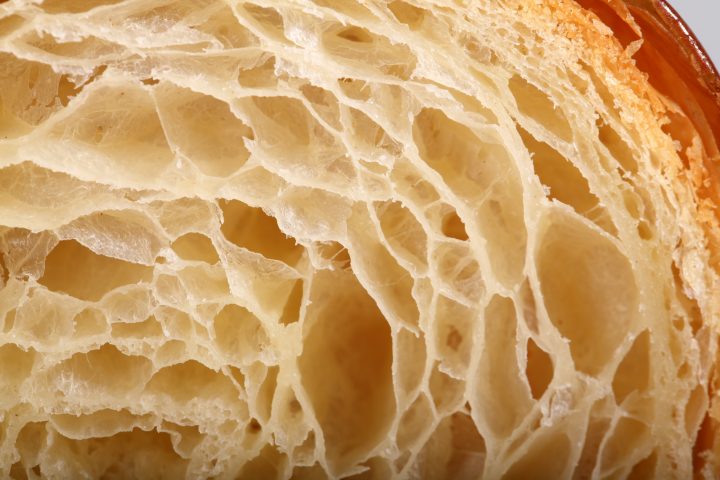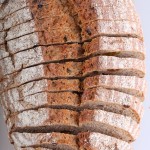
Baking croissants is always a work in progress, hopefully these answers are useful if you are up for the croissant baking challenge…
A lot of (first time) croissant bakers ask pretty much the same questions when tackling this challenging pastry. We composed a list of the top questions with our answers. Pretty sure your question will be answered here. Now lets get to the point of your very valid questions!
GENERAL RECIPE QUESTIONS
Why is your version a three day recipe?
The three day croissant recipe schedule is done for the right planning of the whole process so you can make your croissants on the third day in the morning, but of course you can take less time if this fits your timing better. Take a look at our one day version of this recipe too.
I am a first time croissant baker. What is your best advice?
Choose a cold day with a room temperature below 20 ºC / 68 ºF for your first attempt. This way you will have more time for the whole process and less chance of butter being absorbed by the dough. The key is to keep the butter solid between the layers of dough, this is what gives the croissant its flakiness.
My first attempt croissants look nothing like the ones in your pictures! What did I do wrong?
Do not expect to get perfect croissants the very first time you try to make croissants, most people need to make them 3 to 4 times to get the general feeling for the process. There is no substitute for practice and experience. There is no way to hide little mistakes in your technique when making croissants, so work very precise and follow the instructions to the letter. One small mistake is no problem but several small mistakes add up!
My croissants have a bread-like crumb and no layers. What did I do wrong?
Several factors can be the cause of this. Most likely it is an accumulation of things going sideways. It starts with pressing too hard on the dough to try and lengthen it while it is already fighting back. Keeping at this for a while means, next to the pressing on the dough, you are taking too long and the butter starts to get warm and is absorbed by the dough. So in this case, while still learning and getting better and faster, until you do make sure you build in extra fridge time to cool the dough and then continue. Handle the dough with care, gently elongate without pressing too much or putting your weight into it.
Can I turn your croissant recipe into a sourdough version?
We would recommend finding a recipe that is already a worked out version for sourdough croissants. We are not really a fan of the sour taste in pastry and for that reason we do not have enough experience to guide you to a good enough result.
Can you provide the measurements as ml, tsp, cups, instead of grams for all the ingredients?
We very much recommend weighing your ingredients. Professional bakers use scales (also in the US) and in Europe home bakers do too. A scale will give you the exact same weight every time. Which is absolutely needed if you consistently want to make good bread and especially good pastry. You can get a scale for the same price as a few sacks of good flour and less than a lot of baking tools you already own, so if possible, go and get one!
What are the measurements if I only want to make half of your recipe?
If you halve the recipe, the dough square should be 18.4 x 18.4 cm and the butter slab 12 x 12 cm.
Put the butter slab on top of the dough square and wrap the butter.
Roll the dough into a 20 cm x 30 cm rectangle.
Fold letter style to a 20 cm x 10 cm rectangle.
Turn dough 90 degrees.
Roll from the short 10cm side to a 20cm x 30cm rectangle (the short 10cm side will get 30cm).
Turn dough 90 degrees.
Roll from the short 10cm side to a 20cm x 30cm rectangle (the short 10cm side will get 30cm).
Turn dough 90 degrees.
Roll from the short 10cm side to a 20cm a 55cm rectangle (the short 10cm side will get 55cm).
The size of the final dough, right before cutting, should be 20 x 55 cm.
Although it is possible to use halve the dough we advise to make the full recipe as described in the recipe as the geometry of the shapes are much easier to work with.
You can always use halve and freeze the other halve.
I want to bake croissants, but live in a tropical location. Can I still make them?
We have gotten tips from people who have successfully baked croissants in the tropics. The top tips:
Cool ingredients and even utensils in the fridge before use, and use the fridge a lot to cool your dough and cool for longer if needed.
Roll the dough at night, when it is cooler. Check the weather reports and choose the coolest period possible.
BUTTER
My butter breaks into pieces. What should I do?
We use organic butter with a high fat content and low water content (about 82% fat). A higher water content tends to make butter hard, which promotes tearing and breaking and ruins the layers. Your butter needs to be pliable and at the same time not too soft at the moment of usage.
Help, butter leaks out when baking!
Your croissants were probably under-proofed. Just let them proof a bit longer so they get wobbly and increase visually in size. When under-proofed the butter tends to leak out from in between the layers and you end up with a butter puddle.
There’s so much butter in these croissants! Can I use less?
We would suggest making the recipe with the amount of butter indicated, enjoy the croissants and just try to eat less instead of a less than buttery croissant.
Next day eat soup and a salad.
FLOUR
Can I use another type of flour than the French type 55 you use?
For a good croissant you need the right type of flour. We have tried at least 5 different types and brands before we found a winner. If you cannot get the type 55 French flour try to find a flour with around 11% protein (this can be an all purpose / plain flour) and make sure it is a good quality flour. Try different brands if needed or use a combination of flours. Using 100% bread flour can make your result ‘heavy’ so try a combination with all purpose for instance.
DOUGH
My dough was too moist and sticky to handle. What should I change?
First of all it seems your flour absorbs less moisture than the type 55 flour we are using and you need to make adjustments by using a little less moisture next time.
My dough resists and shrinks back when I try to roll it out. What can I do?
At any stage when the rolling of the dough gets harder you can cover the dough and let the gluten relax for 10 to 20 minutes in the fridge before continuing.
If you keep on pressing the dough, trying to roll it while it resists, you will damage the layers!
SHAPING, PROOFING & YEAST
Can I use fresh yeast instead of instant yeast?
Yes you can. Use three times the amount given (so for our recipe 33 grams of fresh yeast).
Can I use active dry yeast instead of instant yeast?
Yes you can. Use 1.2 times the amount given (so for our recipe 13.2 grams active dry yeast).
At what stage should I add filling to my croissants?
You add filling just before the shaping / rolling up stage. Be aware that any filling will affect the layers and you will need less filling than you probably think. With chocolate for instance you will need no more than 5 to 7 grams per croissant. Professional bakers use stick chocolate for this, but you can use your own good quality (dark) chocolate. Fillings like jams are often added (injected) after baking.
I want to shape my croissants like a crescent. Why are your croissant not crescent shaped?
According to Raymond Calvel croissants laminated with margarine are formed into the crescent shape, while croissants laminated with butter are left in the straight form. We say, use whichever shape you like best, but do use real (organic) butter!
My croissants do not puff up like yours. What should I do?
First check the ‘sell by’ date on your packet of yeast and see if it is still OK to use it. Also make sure the temperature of your dough and proofing environment are correct.
Ideally you should proof the croissants draft-free at a temperature of 24ºC to 26.5ºC / 76ºF to 79ºF
BAKING
Why are my croissants under/over cooked?
Check the true temperature of your oven and see if any adjustments need to be made there. See our tips on the subject: Bread baking tips: Making the most of your oven.
Why are there pools of butter at the bottom of my baking pan when baking the croissants?
This could be a result of under-proofing, so make sure you proof at the right temperature and take the time to proof to perfection and get that nice wobble in your dough. It could also be you were not as meticulous as needed during the lamination process, so stick to the measurements, make sure they are as exact as possible, the edges are straight and follow our laminating instructions carefully.
Help my croissants split open during baking! What did you do wrong?
We suspect your croissants lack real layering and therefor are more bread-like with a lot of butter incorporated. Because they have this substance and are under-proofed and lack layering, you get an oven-spring during baking and the bread splits at its weakest points. With correct layering you get air pockets which will be able to expand and not rupture.
So try to work on your layering by keeping the laminated dough cool, work fast and do not press on the dough when rolling it but gently elongate it.
I want to freeze my croissants and bake at a later stage. What is the best way to do this?
Check out our tips for retarding and freezing with the one day version of our croissant recipe.
You can always find a way to adjust the recipe to fit your schedule.
What do I do to keep baked croissants fresh?
We would advice to put the croissants you do not eat on baking day in the freezer, after they have cooled. For extra flakiness and ‘almost as good as freshly baked’ you can put them into an oven for about 8 minutes at 175°C / 345°F, straight from the freezer.










Darya says
Hello, the butter leaked out of my croissants during the second proofing, what did i do wrong? I’m guessing I didn’t proof them enough the first, but maybe I am wrong?
Thanks!
Weekend Bakers says
Hello Darya,
What butter did you use with how much fat content and how warm was the room (and dough) when proofing?
Jessica says
Hallo!
Allereerst wil ik zeggen dat ik verzot ben op jullie croissant recept! Al vaak gemaakt en maak er vele blij mee 👌🏻
Mijn vraag is alleen. Kan ik ze na het vormen in de koelkast zetten om ze vervolgens s ochtends alleen te laten rijzen en af te bakken? Of is er een andere manier om ze bij het ontbijt te kunnen eten zonder veel werk nog te hebben ☺️
Jessica says
Sorry ik heb het antwoord al gevonden in het 1dags recept
Weekend Bakers says
Ja, goed dat je het al gezien hebt! Je kunt het recept naar je eigen hand zetten op deze manier, want we snappen het helemaal, snel en vers bij het ontbijt 👌🏻!
Enjoy your pastry baking!
Carmela says
Hello,
I am a first time baker of crossaints. I accidentally froze my dough in the 1st day of fermentation of the dough. Do i need to wait again overnight before rolling it with butter or i can proceed after it thawed out? Thank you!
Weekend Bakers says
Hello Carmela,
These things happen. You can proceed as soon as the dough is at the right temperature, you do not have to wait.
Good luck with the process!
Christina Meisl says
Hello. Can you tell anything about temperatures of dough and butter ?Before laminate I think the dough have to be under 5 degrees so that it not starts rising? But it’s a problem when the Butter gets too cold …..
How can you roll out when you “Refrigerate until day 3“ ? I think the butter will be completely stiff ….
Best regards
C
Weekend Bakers says
Hello Christina,
It is not a problem if the dough slightly rises in the fridge. Our fridge is around 5 C also and the dough puffs up a bit. It is also not a problem if something gets cold. You just wait 10 minutes and then start rolling. Most important is the use of the right butter with the high fat content of around 82%, which is softer and pliable and does not break when colder.
Hope it will be OK!
Ulrick says
What does it mean, when I’m folding my dough, but as im rolling it out, the dough reveals the butter layer from
My
First turn? Im guessing i pressed too hard and my dough got pulled off to uncover my butter?
Weekend Bakers says
Hello Ulrick,
Your own analyses could be very well spot on. You also maybe have not sealed in the butter well enough and have pressed too hard on the dough. Especially in the first stages you need to roll and elongate with a gentle touch as not to damage the layers.
Next time it will be better!
Robert says
Hi,
I make croissant donuts. They come out great in the summer, June to September, but then the texture changes the rest of the year. The exterior is soft instead of crispy, and have a tougher bite feel (more like a bread),instead of delicate shatter feel.
Also, the biggest problem right now is the half of donut that is out of the oil (the raw donut side before donut is flipped in fryer)when in fryer at first blisters, expands a lot, and is super soft at end of fry.
The layers are still great in the interior, but just not the same texture. I’ve trial and error’ed many things, and I think it’s the butter that changes throughout the year.
Any thoughts to why we get a lack of crispness? Why one half of donut is blistered, over expanded, and soft (happens to underproofed donuts too)?
Weekend Bakers says
Hello Robert,
We aren’t exactly cronut experts because we have never made them ourselves. Could the change in climate / moisture / temperature also account for some of the problems you encounter? Maybe in winter you need to add warmer liquid to your dough and need to compensate just a bit with the fryer too??
Hope somebody else can add some knowledge…
Good luck with it.
Syrah says
Hi Robert,
It does sound like your dough might be underproofed when you say it expands so much and unevenly during frying as well as the texture being tougher. The room temperature difference between winter and summer (Netherlands for me, so nothing very extreme even) makes a massive difference in all my bread baking in terms of proofing and rising times. You could either try to make a proofing cabinet at a fixed temperature to get more consistent results (but with croissant dough be super careful not to have it too warm cause your butter will start leaking out before baking even) or by learning what a well risen dough looks and feels like you can go just on intuition eventually (wobbliness of the risen croissants and the way they spring back when poked. Not a very exact science, I know, but since you have the experience from getting good results in summer I’d say you already know what they should be like?).
The other thing you mentioned is the butter changing through the seasons: milk from grass fed cows produces the softer, fattier butter described on this site as the ideal butter and sometimes this means winter butter will have a different fat composition resulting in a completely different (higher) hardness. This combined with a lower room temperature while rolling (harder butter again) might cause some breakage of the butter layer while rolling so try to be extra gentle and maybe even start the whole process with a thinner slab of butter inserted into the dough (adjust dimensions of both the dough and the butter to accommodate for this) with a bit of resting time when you take it out of the fridge and before you start rolling as well.
Hope you’ll have better luck in winter next time with the cronut backing!
Weekend Bakers says
We found it very interesting and helpful to read your excellent comment on Robert’s cronuts question.
Thank you for sharing your expertise with us.
Ali Salem says
Hi Dears
I tried your recipe for croissants and it was brilliant except final stage ( baking ) , during baking the surface of croissants breaks and takes apart, if possible i want to send a photo to explain it to you , and it is appreciated if you could help me to solve this problem
Weekend Bakers says
Hi Ali,
Your croissants might be under-proofed and needed more time before baking.
You can show us your pictures by uploading them here if you want:
www.weekendbakery.com/send-…your-loaf/
Then we can take a look and see what you mean exactly.
Susi says
I Have the same issue, after shaping my croissant doesn’t really puff enough even though I proofed for 2 hours and 5 hours and during baking in the oven the butter melted. come out from the oven still can see the butter layer but the inside not like honeycomb texture, more like a bit dense, wet buttery layer.
Weekend Bakers says
Hello Susi,
Like we said a few comments below: This could usually be a sign of a less than perfect lamination process. So make sure you stick to the recipe especially when laminating, with measurements as exact as possible and making sure you work the dough without pressing on it (gently elongate) and with enough cooling where needed.
If the layers are not there enough, you get a more compact dough that is not going to get cooked properly during the time in the oven.
Nest to this we think it would be a good idea to first check your yeast and see if it is not out of date for example and also inspect your oven and see if it is working properly and preheated to the right temperature. Also check our oven tips for this: www.weekendbakery.com/posts…your-oven/
aziza says
hello
What are the damages of croissants?
Weekend Bakers says
Sorry, we do not understand your exact question?!
Ali says
Hello
Please can you tell me why most of the time my dough puffs during the first fermentation stage and also after I finish the laminating stage (when I refegirate the laminated dough) ?? However, It does not puff enough after shaping the croissants ?
It seems to me the yeast losts all of its energy during the first stages I have mensioned first
Thanks
Weekend Bakers says
Hello Ali,
What kind of yeast are you using?
Roesdien says
Hi..awesome recipe…I have tried it and came out beautiful with same layers as yours. Just followed recipe and process..
I want to know if I use coarse salt in recipe will it have a negative effect on my croissants dough??
Weekend Bakers says
Hello Roesdien,
Thank you and great to read about your results. We would not think it a good idea to use coarse salt with this delicate pastry, not for the possible taste of salt crystals in your carefully laminated dough . So if possible buy fine salt or maybe grind it before use.
Kevin Beasley says
why are my croissants flaky on the outside, but uncooked on the inside?
Weekend Bakers says
Hi Kevin,
This is usually a sign of a less than perfect lamination process. So make sure you stick to the recipe especially when laminating, with measurements as exact as possible and making sure you work the dough without pressing on it and with enough cooling where needed.
If the layers are not there enough, you get a more compact dough that is not going to get cooked properly during the time in the oven.
Rudy says
Hello. I’m a new croissant baker. I use mixer to mix my very first dough. Is it also need only 3 minutes to mix the dough? And i only have 3 choices of speed on my mixer. Low. Medium .fast. Which one should I use for the 3 minutes dough mix? Thank you
Weekend Bakers says
Hello Rudy,
It is a bit hard for us to answer this question, because we do not know the workings of your mixer and how it handles this dough, but based on an average mixer we would suggest the low speed setting. Use the dough hooks, keep an eye on the dough and if possible judge when you have reached low to moderate gluten development.
joselito says
why does the croissants brake while proofing, before it doesn’t do that but now it does, no change in recipe. could it be flour issue? i’m using t45 gruau rouge from moulbie.
Weekend Bakers says
Hello Joselito,
We do not understand what you mean by ‘brake’ while proofing, but the flour you use can make a big difference, especially the percentage and type of gluten. We have not used the flour you mention, but if you have had success before and only changed the flour and got this results then the ‘culprit’ would be the flour.
David Guthrie says
I had the impression that the correct (or best?) flour to use for croissants was T45 farine de Gruau. I recently acquired some and indeed it does perform well. Also, I decided to try a recipe which included 2 eggs to 500g flour and 200ml water rather than 250g in the détrempe. The result was just about what I was aiming for. I tend to like my croissants plain rather than sweet, so use 2 to 3 tsp sugar. In addition, I start the croissants off at 220℃ for 5 minutes, then drop to 190℃ for the remainder. This gives oven spring and produces the desired effect. I also found a neat way to get the butter into a straight-edge rectangle. Fold a sheet of greaseproof paper to form an envelope of the right dimensions, beat the butter to approximately the right shape, but smaller than the ‘pocket’ in the envelope, and roll out the butter to the pocket’s edges; simple, but effective; I’ll try it on my next batch.
Weekend Bakers says
Hello David,
Thank you for sharing your knowledge and experience. It sounds very good. We hope to be able to try the farine de Gruau too in the future. And you do have a point with the less sugar part. We tend to use less and less sugar and less salt as ‘time goes by’. Trying to get it just right for our taste, allowing other ingredients to shine.
Enjoy your experimenting and pastry baking!
David Guthrie says
Thanks. The envelope method worked a treat. Some French recipes call for a mix of T45 and T55 flours … more fun! The T45 works well and has a nice flavour. I also tried another idea from a French cookery website: replace 50g of water/milk with two eggs (that’s 500g flour:250g water/milk. This gives it a nice texture inside, what the French call ‘brioché’ – brioche-like. Once you’ve got the knack of the procedure, croissant making is a joy. Not to mention the essential job of eating one fresh from the oven!
Weekend Bakers says
Thanks again David, that sounds like a great variation on the theme.
Joshua says
What happens if I use dabble sugar and salt and imp but a single flour and water yeast
Weekend Bakers says
Hello Joshua,
Sorry but we do not understand what you are asking exactly?!
Jill says
I am (trying)to make croissants. I am using the Tartine Cookbook recipe. The leaven and poolish has not passed the float test but looks really bubbly and ready. They have been out on the counter 3 hours after a night in the fridge. Did they go bad??
Weekend Bakers says
Sorry Jill, we cannot really help you with this one, we never do the float test and have never tried the Tartine croissant recipe.
In general poolish does not go bad that quickly, but it can get too ripe and the gluten will be damaged (it turns soupy and you can see the rim of where the poolish has been and it has already shrunk back in the bowl) and so it will not add to the strength of your final dough. Bubbly sounds good. Smell is also a good indicator if something is still good or has ‘gone bad’. So any time the smell is off putting and sharp, do not use it.
Hope you still did OK with your batch.
PRKelly says
I made the most beautiful looking croissants; a true work of art. THEY TASTED TERRIBLE. The only thing I can think of is the yeast. I may have used too much or the wrong kind. Maybe I proofed too long. Oh well, back to the kitchen. They sure were pretty, though.
Weekend Bakers says
Hi,
We do not hear this very often, looking good but tasting terrible. Just buy some new fresh or instant yeast, measure it and try again!
Good luck with your next batch and enjoy!
Sara says
Thanks for the instructions my croissant are heavy and under bake in the middle what is the reason for this?
Thanks
Weekend Bakers says
Hello Sarah,
Was it your first time baking croissants and at what temperature did you bake and for how long? Can you maybe also tell us what type of flour you used?
zee says
i have made croissants. i followed the recipe. after baking its not fluffy. where i did mistake. is it a problem in my recipe or oven. plzzz guaid me
Weekend Bakers says
Hello Zee,
This is a challenge for us to judge, because there could be a number of factors at play. That is the reason the perfect croissant is such a difficult thing to master. Most people, including ourselves, need many tries to come to a good result.
Read the answers to the questions above (especially under ‘general’ and ‘baking’) and see what might have gone not so well.
Lots of people under-proof their croissants, so make sure they are proofed well and at the right temperature before baking.
Good luck with it!
Yaki says
Before ive been using corman croissant butter, but now can i use anchor unsalted butter or anchor salted butter or margarine?..what is the ratio if i’ll use this?
Please help me and thank you chef!
Weekend Bakers says
We would use the unsalted butter (also look at the fat content it needs to be high over 80%) and stick to the salt content in the recipe.
annamaria says
per questa ricetta, posso usare il lievito madre? stessa prpcedura?
Weekend Bakers says
Sorry Annamaria, we do not speak Italian. Yes we think that is very well possible, but we do not have the experience to advice you on the procedure. Hope you will find a good recipe soon.
Lucie says
Hello,
I used 16g fresh yeast and croissants smelled like alcohol after baking. Why? Is it because of using fresh yeast?
Thank you,
Lucie
Weekend Bakers says
The amount of fresh yeast you use is even a bit on the low side, normally you use about 3 times the amount of instant yeast (3 x 11g = 33g), so this should not be the problem with the alcohol smell. Does the dough before baking and during laminating also smell?
Lucie says
I’m sorry, I forgot write – I used 16g fresh yeast for 250g flour. The dough changed its smell during 3 days, but I think it’s normal. Croissants smells and tastes like alcohol third day during and after baking. Maybe 3 days of making it’s too long for fresh yeast.
Thank you, Lucie.
Weekend Bakers says
Hello Lucie,
This is a bit of a puzzle for us, because normally it should not be a problem. Of course the dough has a ‘yeasty’ smell, but this should be pleasant and after baking it should not be tasted. Maybe try a different package of yeast and also make sure your fridge temp is around 4 to 6 degrees Celsius.
Good luck with it!
Lena says
Is there harm in proofing my croissants in the fridge for too long? Also, I am having a lot of difficulty rolling out my dough—it is very cold (so I know the butter melting is not the issue) but I have to really struggle to roll it out. What could be the problem?
Weekend Bakers says
Hi Lena,
Do you have trouble rolling out because the dough is fighting back or because it will not roll out at all and feels dry?
Eneida says
Hey, Ive the same problem. For the 1st fold, it normally feels too dry/cold to roll out. For the 2nd and 3rd fold, it normally fights back. I know solving the 2nd and 3rd fold is by resting it in the fridge 10 to 20 mins at a time but what’s the issue with the 1st fold? Is the dough overworked?
Weekend Bakers says
If your dough is really cold and hard from the fridge, leave it to rest for 10 minutes on your worktop and try again. Do not fight the dough or push too hard because it will damage. Also, try to keep the dusting of flour on your worktop to a minimum, so no extra flour is incorporated into the dough, making it drier. If you find your dough is a bit too dry overall, it could also be your flour absorbs just a bit more water than ours, so you could also try and see if your dough would benefit from just a tiny amount of extra water, added when making the initial dough.
dabir says
Why did Crossiant bread crumble in the oven?
Weekend Bakers says
Hello Dabir,
We do not know exactly what you mean by ‘crumble in the oven’ but hopefully you can find your answer between our frequently asked questions (see under ‘baking’):
www.weekendbakery.com/posts…questions/
Douglas says
When you are rolling the dough to 26 x 26 cm to prepare it for the butter block, how thick is your dough?
I’m finding my dough is pretty thick from the overnight proofing. Rolled out to 26 cm x 26 cm it tends to be around 1.5-1.7 cm thick. The dough can be rolled out to twice that area before its thickness approaches 1 cm or slightly under. I’m thinking my yeast is proofing faster than normal and I should try cutting the yeast amount a bit (I’ve been using Saf Red Instant Yeast).
Weekend Bakers says
Hello Douglas,
We do not know about your yeast (the temperature control can also be a factor) but the most important thing is to stick to the measurements of the 26 x 26 cm and to get the square as perfect as possible and with an even thickness, the thickness itself is less important.
Faina Letoutchaia says
Dear Ed & Marieke,
Thank you so much for your wonderful blog and recipes!
I would like to make a comment about yeast amount to put into dough.
There is a common misconception about how much yeast to use.
The point is, it does not matter as much as people usually think.
Yeast is a living cells that under the best for them conditions divide about every 15–20 minutes. Which means that every 15_20 min the number of yeast cells doubles. As the amount of nutrients is depleted, and the byproducts, such as carbon dioxide, accumulate, the division of cells slows down, and then stops.
Let us conduct a mental experiment.
Suppose we have 2 identical jars, and each has 100 ml of sugar solution.
Let us put 2 yeast cells into jar 1, and 4 yeast cells into jar 2.
Let it be 20 min time period for each cell division.
In 20 min we will have 4 yeast cells in jar 1, and 8 cells in jar 2.
40 min from the beginning of the experiment we are going to have 8 cells in jar 1, and 16 cells in jar 2. And so on.
You can easily see that the number of yeast cells in jar 1 is one cell division behind the number of cells in jar 2 at any moment of time. Which means that the yeast culture in jar 1 will reach saturation one cell division time period later than the culture in jar 2.
All it means that if you use 10 g of yeast instead of 5g, your dough will be ready some 15–20 minutes sooner, and that’s all the difference. If you use 6g of yeast instead of 5, the difference will be unnoticeable.
It also means that you can estimate the number of cell divisions it takes for dough to reach desired condition under given temperature and adjust the amount of yeast to use if you want to save 30 min of your time, or stretch the process a little if needed.
I won’t recommend to increase the amount of yeast so much that it will take just one or two cell divisions to deplete the sugars in your dough — it will not allow dough to ferment properly and tiny bubbles of gas to accumulate.
All what I want to say is don’t sweat over the small differences in the amount of yeast to use, be it live, active, or instant yeast. Basically, those are all the same. Just the several minutes difference in time to become active. Then they all go on dividing in the same way.
Best, Faina
Weekend Bakers says
Thank you Faina, for your insights on this subject and your clear explanation. We also did a posting on dough temperature and its relation to yeast activity: www.weekendbakery.com/posts…mperature/
Extending the proofing / fermenting process can have other benefits too in terms of taste and texture for example.
Monika says
I have made croissants many times, and they always turn out wonderfully (thanks for your tips.) But I have an issue with my ham and cheese croissants. I fold them like a chocolate croissant in a rectangle and the cheese always leaks out. I have tried many different cheeses and always have the same issue. Should I try a different fold or close the edges? Do you have any suggestions?
Weekend Bakers says
Hello Monika,
You are doing everything right except probably for the amount of cheese you are using. In croissants and also the rectangles of pain au chocolate you probably always need less filling than you think. With chocolate for example you use 5 to 7 grams, which seems like nothing, but it works. Of course with wonderful and delicious cheese you think ‘more is better’ we understand, but try to put less cheese in and only in the middle, keeping away from the edges and see how that goes. Or try to add the cheese to the croissant shape and also stay in the middle when adding the filling.
Hope this helps.
Happy baking and filling
Kylee says
When taking my dough out of the fridge it was pretty dense. I’m finding it hard to even roll it out. Is there anything I can do or is the dough a total loss.
Weekend Bakers says
Hi Kylee,
It should be a little bit airy and is somewhat stiff, but you should be able to gently roll it out. It feels a bit like airy clay, but the disc of dough only needs to be rolled out to 26 x 26 cm, so not a lot. We presume it was well wrapped and has not dried out. Otherwise leave it for a short while so it gets a bit warmer and then roll it.
Good luck with it!
Theo says
When I do the turns, there is butter poking out of the dough. Even though it is my first time making a crossoint, how do I prevent this?
Weekend Bakers says
Hello Theo,
We hope you might recognize one of the following things not going to plan, so you can adjust:
You did not encase the butter well enough in its envelop.
You pushed too hard on the dough or your butter was getting a bit too warm.
Or maybe even a combination of these things.
So just give it another try and work precise and make extra use of the fridge when necessary and do not press on the dough with your body weight.
If you want to practice more often but find the three day process a bit long, check out our one day version: www.weekendbakery.com/posts…nt-recipe/
Good luck with it!
Jonas Rieback says
Your croissants looks awsome! Seems like a great recipe and I really like the detailed description. But I’m wondering about the yeast. Going to use fresh yeast and 33 grams (6.6% in bakers %) seems like a lot of yeast?
Weekend Bakers says
Hi Jonas,
It is a general rule, also used in regular bread baking and for this enriched dough, either you use some more yeast (be it instant dry or fresh) or you can also use special yeast for enriched dough (usually not that readily available for home bakers). Sometimes fresh yeast can be a little bit more ‘enthusiastic’ than the dry stuff. It depends on your experience, how much exactly you are going to use in the end to get a good result. We would always suggest using around the 30 gram mark for your first attempt.
Marini says
Hi
Do you offer a 3 days course of how to make a plain croisant?
Thanks
Weekend Bakers says
Hello Marini,
At the moment we do not offer any courses ourselves. You can check out our page with an overview of bread classes given in Holland here: www.weekendbakery.com/posts…en-volgen/ (all in Dutch)
But you have to check if they also offer courses for croissant baking because there are not that many that do.
Hopefully our video and tips can help you too.
Greetings,
Ed & Marieke
Alam says
Why croissants is like bread after baking
Weekend Bakers says
Hello Alam,
If your croissants are more like brioche bread it is because the butter has been absorbed by the dough. It usually is a combination of factors: You press to hard on the dough because you want to lengthen it and it resists. Also because of this it takes longer than it should and the butter is getting warmer and gets absorbed. So you should use the fridge more often to cool the dough and butter when this happens. And as you gain experience you will also work faster and faster and know better how to elongate the dough without pressing too much.
Thuy Nguyen says
Hi Weekend Bakery,
I followed your recipe and my first croissants came out perfectly. Am so happy with it.:)
Thanks for your great guidance and tasty recipe.
All the best,
Thuy Nguyen
Weekend Bakers says
Thank you again Thuy, for trying and liking our recipes and braving the heat of Vietnam to make excellent pastry.
Greetings from Holland,
Ed & Marieke
Don says
Can I freeze unbaked croissants? If so, at what stage is it best to do so?
Weekend Bakers says
Hello Don,
We recommend the following method: Place the shaped croissants on a sheet of baking paper in a container and make sure they do not touch each other. Cover and proof croissants for one hour at room temperature to kick start the proofing process. Now place the container in the freezer.
At the bottom of our one day croissant recipe you will find all information on retarding and freezing your croissants. www.weekendbakery.com/posts…nt-recipe/
Enjoy the pastry baking!